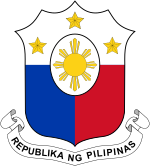Coat of arms of the Philippines
| Coat of Arms of the Philippines | |
|---|---|
| File:Coat of Arms of the Philippines.png | |
| Versions | |
 Version of the Coat of Arms of the Philippines without the Bald Eagle and Lion-Rampant. Only used as markings on government-owned vehicles. | |
| Armiger | Philippines |
| Adopted | 1946 |
| Shield | Paleways of two (2) pieces, azure and gules; a chief argent studded with three (3) mullets equidistant from each other; and, in point of honor, ovoid argent over all the sun rayonnant with eight minor and lesser rays. |
| Motto | Republic of the Philippines Republika ng Pilipinas |
| Other elements | Bald Eagle of the United States and Lion-Rampant of Spain (the charge of Kingdom of León) These elements were not included in Republic Act No. 8491 in 1998, and therefore considered removed, but the change has not been implemented pending ratification by national referendum. |
| Earlier version(s) | With motto: "Isang Bansa, Isang Diwa" With scroll reading: "Republic of the Philippines" |
| Use | Various Philippine Government departments |
The Coat of Arms of the Philippines features the eight-rayed sun of the Philippines with each ray representing the eight provinces (Batangas, Bulacan, Cavite, Manila, Laguna, Nueva Ecija, Pampanga and Tarlac) which were placed under martial law by Governor-General Ramón Blanco during the Philippine Revolution, and the three five-pointed stars representing the three primary geographic regions of Luzon, Visayas, and Mindanao. In the blue field on the left side is the Eagle of the United States, and in the red field on the right is the Lion-Rampant of Spain, both representing colonial history. The design is very similar to the design briefly adopted by the Commonwealth of the Philippines in 1940. It is also used by the Philippine National Bank.
The national coat of arms was adopted, pursuant to Commonwealth Act No. 731, which was approved on July 3, 1946. The coat of arms was designed by Captain Galo B. Ocampo, secretary of the Philippine Heraldry Committee.[1]
The blazon of the coat of arms from the Philippine Government website is as follows:
Paleways of two (2) pieces, azure and gules; a chief argent studded with three (3) mullets equidistant from each other; and, in point of honor, ovoid argent over all the sun rayonnant with eight minor and lesser rays. Beneath shall be the scroll with the words "REPUBLIKA NG PILIPINAS," inscribed thereon.[2]
The words on the scroll have undergone many changes since Philippine independence. From independence in 1946 until 1972, when President Ferdinand Marcos declared martial law, the scroll contained the words "REPUBLIC OF THE PHILIPPINES." From 1979 until the overthrow of Marcos in 1986, the scroll had the words "ISANG BANSA ISANG DIWA" ("One Nation, One Spirit") inscribed. After the overthrow of Marcos, the scroll changed to the current "REPUBLIKA NG PILIPINAS". On February 12, 1998, with the approval of Republic Act No. 8491, the eagle and lion on the lower half of the shield were not specified, and therefore removed. However, the modified arms are not in wide use, pending the ratification of the law by a national referendum called for that purpose, as mandated by the Philippine Constitution.
Early version of the coat of arms of the Philippines that the scroll written in English as "REPUBLIC OF THE PHILIPPINES", is used in government invoice, government institution seals (especially the Bureau of Immigration), markings in government-owned public vehicles funded by representatives, seals of the municipalities and (component) cities, and for use of embassies and consulates (or international version of Philippine coat of arms). The shade of azure was navy blue, as also suited with the Flag of United States.
Historically, the arms of Castile and Leon is the royal representation of the Philippines to the royal court of Spain. But the Spanish-descended Filipinos were proud that these two arms would represent Philippines.
Gallery
Historical
-
Coat of arms of the Spanish East Indies (1565–1899).
-
Arms of the Commonwealth of the Philippines (1939-1946).
References
- ^ "House of Representatives of the Philippines - Audience: Students - The National Coat of Arms". Retrieved 2008-12-14.
- ^ "Chan Robles Virtual Law Library - Republic Act No. 8491". Retrieved 2010-11-10.



